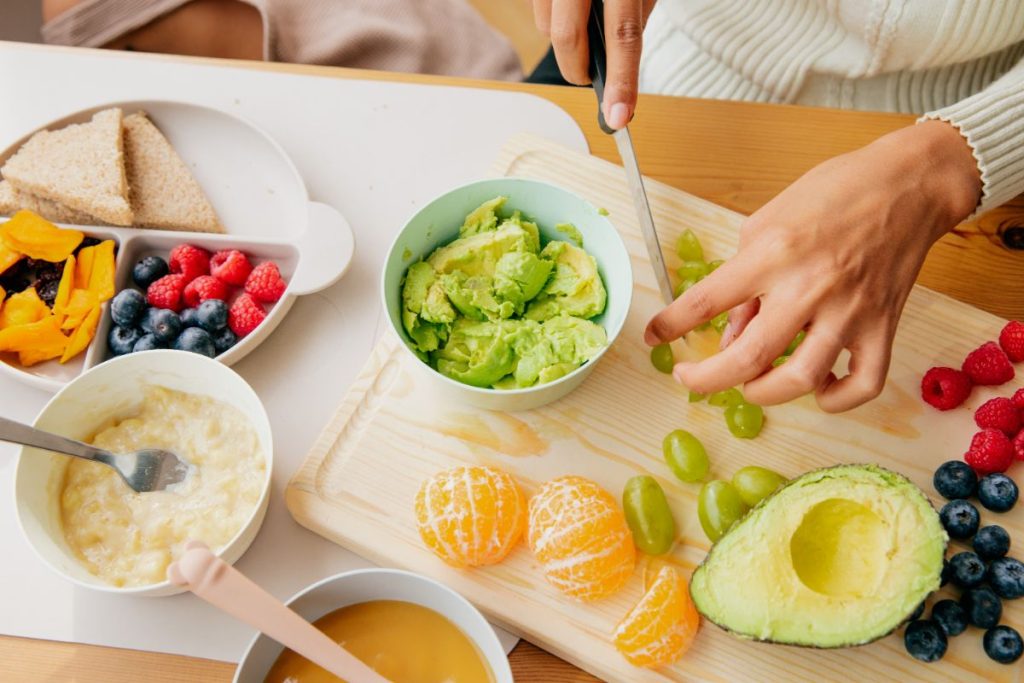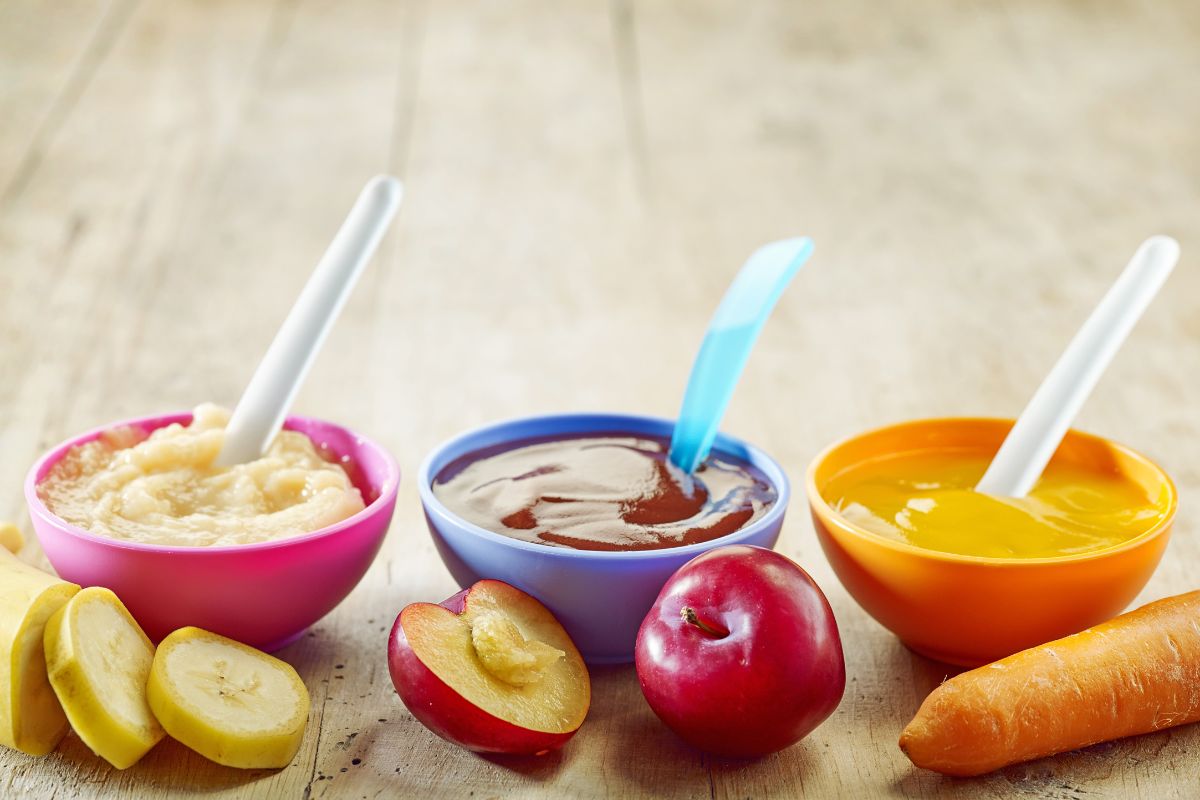To dehydrate baby food in a food dehydrator or an oven, prepare and blend the ingredients to make a puree. Line your dehydrator tray or baking sheet with parchment paper and spread your puree thinly. Place them in a dehydrator or inside an oven and process them at a temperature of 140°F to 170°F until the puree sets and dries.
Table of Contents
How to Dehydrate Baby Food in a Food Dehydrator
Here’s how to make dehydrated baby food in a food dehydrator:
- Preheat the food dehydrator to 125 degrees Fahrenheit.
- Gather your desired ingredients, including fruits, veggies, or protein sources.
- Wash the ingredients thoroughly in cool running water to remove dirt and pesticides. Depending on the type of fruit or veggies you’re using, you may need to peel them and remove any seeds, cores, or pits. If you’re using meat, make sure to cook it through to a safe temperature of 165°F.
- If you are adding vegetables like carrots and peas, you’ll need to blanch them. Boil them for 2-3 minutes, and then quickly cool them in ice water to stop the cooking process. Blanching helps maintain nutritional value, flavor, and color.
- Make a puree by placing all of the desired ingredients in a food processor or blender and blending them until the texture is silky and smooth.
- Use silicone baking mats or parchment paper to line food dehydrator trays. Spread the puree on the trays in a thin layer, similar to fruit leather, leaving 1/2 inch of space between each tray.
- Following the dehydrator’s instructions, process the puree at the specified temperature and recommended drying time. Usually, the temperature for dehydrating baby food ranges between 120°F and 140°F.
- Dry the puree until it’s crispy and snaps easily when bent. The type of ingredients and thickness of the puree will determine the drying time.
- Once fully dried, cut it into small pieces and grind it using a food processor or a blender to make a fine powder.
- Sift the powder to remove any bits that aren’t uniform. Dry the mixture to room temperature.
- Transfer the baby food powder into an airtight container and label it with the contents. Keep the baby food powder in a cool, dark location for six months to a year. To use, reconstitute with water or fruit juice and mix well.

How to Dehydrate Baby Food in an Oven
If you don’t have a food dehydrator, you can use an oven to make DIY homemade baby food:
- Preheat the oven to the lowest temperature or 170°F.
- Start by collecting the ingredients that you need. You can use fresh fruit or a variety of dehydrated fruit powders, including apple, banana, or peach.
- Under cold running water, wash any fresh ingredients to remove dirt and debris. Peel and remove seeds and pits, depending on the type of fruit that you’re using.
- Blanch any ingredients that require blanching. If you want to add veggies like carrots and peas to your fruit puree, you’ll need to blanch them before blending them. Place them in boiling water for 2-3 minutes, then transfer them to an ice bath to cool.
- To make a puree, place the fresh and dry powdered ingredients in a food processor or blender and blend them until well combined.
- Use parchment paper to line a baking sheet and spread the prepared puree on top of it in a thin layer no thicker than 1/4 inch.
- Place the trays in the preheated oven. Prop open the oven door to promote airflow. Let the oven run for 3-5 hours until the food is completely dry and crispy.
- Grind the crispy dried baby food in a blender or food processor to form a fine powder. Sift the powder and allow the powder to cool to room temperature.
- Store the powdered baby food in airtight containers for up to one year.
How to Make Fruit Puree for Dehydrating Baby Food
To make baby puree for dehydrating baby food, pick ripe fruits that fit your baby’s age and dietary requirements.
- Wash the ingredients well to get rid of any dirt or pesticides.
- Remove the core, seeds, or pits, depending on the type of fruit.
- Blanch or steam any fruits that require it. The type of ingredients will determine whether you need to heat or steam them before making a puree.
- Use a blender or a food processor to blend the fruit while adding a small amount of liquid, such as water or formula, to achieve the desired consistency.
- Start with a thick puree and add the liquid gradually while blending until smooth.
- For a smoother texture, strain the puree to remove any fibrous bits or skins using a fine-mesh sieve or a food mill before dehydrating the puree.

Is Dehydrated Food Good for Babies?
Yes, dehydrated food is good for babies. Dehydrated baby food can combine several nutritious ingredients providing the nutrients that growing babies need.
Fruits and vegetables retain most of their nutrients when dehydrated because no cooking is involved. Additionally, dehydrated food lasts longer, and you can prepare a large batch of food in advance and have it ready to go when your baby is hungry.
What are the Benefits of Dehydrated Baby Food?
- Convenience and portability: Dehydrated baby food is portable and light and great for travel, outings, and emergencies because it can be conveniently transported in a bag.
- Cost-effectiveness: You can buy seasonal food in bulk and save money while extending the shelf life of healthy ingredients.
- Extended shelf life: By eliminating moisture, the food stays fresh for a long time without refrigeration or other chemicals.
- Retention of nutrients: The dehydration process removes moisture while retaining vital vitamins, minerals, and enzymes that are good for your little one’s development.
What are the Best Dehydrated Foods for Babies?
- Dried fruits such as mangoes are a great source of vitamins, minerals, and fiber.
- Eggs are rich in protein, iron, and zinc. They also contain a lot of choline, vital for brain growth.
- Meats such as chicken and turkey are good sources of protein, iron, and zinc.
- Vegetables like sweet potatoes, beets, and cucumbers are highly nutritious.
- Yogurt drops: dehydrated yogurt drops are delicious and calcium-rich baby food.

How Should Dehydrated Baby Food Be Stored?
Dehydrated baby food should be stored in an airtight container in a cool, dark place, such as a pantry or cupboard. Label the container with the date to help you keep track of how long the food has been stored.
Avoid storing dehydrated baby food in the refrigerator or freezer. Cold temperatures can ruin the food, and there is a greater chance of moisture infiltration. If the dehydrated baby food changes color, becomes moldy or develops a strange odor, it has gone bad and should be discarded immediately.
What is the Shelf Life of Dehydrated Baby Food?
Properly dehydrated and stored baby food can last for six months to a year. Always label dehydrated baby food to keep track of the useful shelf life.

